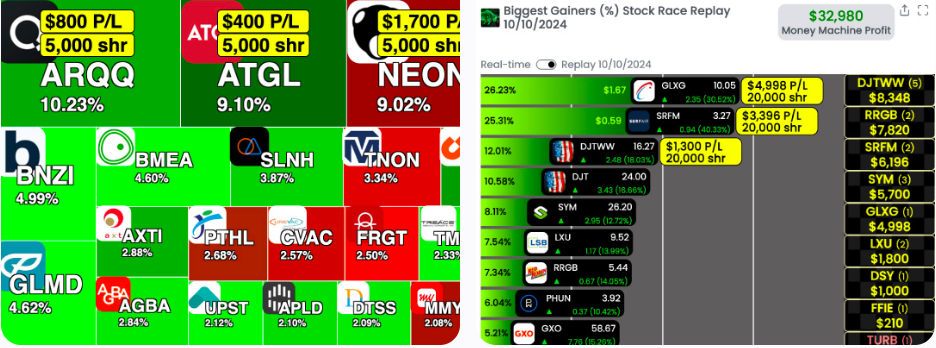Top 10 Suggestions For Evaluating The Performance And Accuracy Of Ai Stock Trading Platforms
To ensure that you are making use of a platform that is that can provide accurate and reliable forecasts and insights it is essential to evaluate the accuracy and efficiency of AI stock-predicting and analyzing platforms. Here are the ten most crucial tips to evaluate these platforms:
1. Backtesting Results
What to Look Out For Make sure the software permits backtesting. This will allow you to assess the performance of predictions from historical data.
Why It Matters : Backtesting is a way to validate an AI model by comparing its predictions to the results of previous tests.
Find platforms that provide the ability to set backtesting parameters.
2. Real-time performance tracking
What to look out for What the platform does under real-time conditions.
Why It’s Important The real-time results are more reliable indicators of the efficiency of a platform than only historical backtesting.
TIP: Sign up for a free demo or trial account to test the accuracy of market predictions against actual movement.
3. Prediction Error Metrics
What to look for To measure the accuracy of prediction, try using metrics such as the Mean Absolute Error(MAE) and the Root-Mean Squared Error(RMSE) or Rsquared.
What is the significance of these measures provide a quantitative measurement of how accurate the predictions are to the actual results.
Tip: Platforms who openly provide these measures have more transparency.
4. Winning Rate and Ratio of Success
What to Check: The platform’s win ratio (percentage for correct predictions) and the percentage of success (profitability on the basis of the predictions).
What is important: A high win rate and success ratio indicates better predictability and profitability.
Tips: Be wary of platforms that claim false winning rates (e.g. 90, 90 %+), since no system is perfect.
5. Benchmarking Market Indices for Benchmarking
What to look out for: Compare predictions and performance of the platform with the major market indexes.
What’s important This will help you determine if your platform outperforms or is underperforming the overall market.
Tip: Do not only seek out short-term gains but also an overall performance that is consistent over a longer period.
6. Consistency in Market Conditions
What to be looking for What is the performance of the platform when there are different market conditions.
Why is it Important A solid system will be successful not only under favorable market conditions, but as well in any other circumstance.
Tips: Use the platform during times of volatility or downturns in the market.
7. Transparency in Methodology
What to Look For Learn about the AI models and algorithms used (e.g. neural networks or reinforcement learning).
What is important Transparency is crucial since it lets you assess the reliability and scientific accuracy of the system.
Beware of platforms that use “black box models” that don’t clarify how they generate predictions.
8. User Review and Independent Testing
What to Look For Reviewer reviews, and look for independent tests or third-party reviews of the platform.
Why It Matters: Independent reviews and testing give unbiased insight into the reliability and effectiveness of the platform.
Tips: Search for comments on forums like Reddit, copyright or financial blogs.
9. Risk-Adjusted Returns
What to Look Out For The platform’s performance can be measured by using a risk-adjusted metric like Sharpe Ratio, or Sortino Ratio.
Why it is Important What is important? on the level at which risk is taken in order to earn returns. This provides a more complete picture of performance.
Sharpe ratios (e.g. above 1) indicate a higher risk-adjusted return.
10. Long-Term Track Record
What to look for: Find out the overall performance of the platform over time (e.g. 3 to 5 years).
What is important. Long-term performance is a better indicator for reliability than results that are short-term.
Do not use platforms that show only the results of a short-term study or a cherry-picked achievement.
Bonus Tip Test using an account demo
Try out the platform with an account for a demo to test how precise it can be in real time. You can assess the accuracy and efficiency of the system firsthand.
These suggestions will allow you to determine the accuracy of AI stock-predicting and analysis platforms and pick one that best suits your trading goals and willingness to take risks. Be aware that no platform can be guaranteed to be 100% accurate, so combining AI insights with your own research is usually the best approach. Take a look at the recommended get more information about investment ai for site examples including ai investing app, best ai trading software, ai stock, best ai stock, ai for investment, best ai stock trading bot free, options ai, best ai trading software, investment ai, stock ai and more.
Top 10 Tips For Assessing The Regulatory Conformity Of Ai Stock Analysis And Prediction Platform
The compliance with regulatory requirements of trading platforms that employ AI to predict/analyze the price of stocks is a significant aspect. Compliance helps to ensure that the platform is operating within the legal frameworks and safeguarding user data. These are the top 10 suggestions to evaluate the compliance with regulations of these platforms:
1. Verify that you have a valid license and registered
Regulators: Check that the platform is certified and registered with relevant financial regulatory authorities (e.g. SEC in U.S.A., FCA UK, ASIC Australia).
Verify the broker collaboration If your platform has a partnership with brokers or brokers, you need to make sure these brokers are licensed and regulated.
Public records: You can check the official website of the regulatory body to determine if the platform is registered and if there have had any violations over the years.
2. Compliance with the Data Privacy Assessment
GDPR – If your website is located in the EU or serves users from the EU ensure that it is compliant with GDPR.
CCPA for users living in California Verify conformity with the California Consumer Privacy Act (CCPA).
Policies on handling data: Read the privacy policies of the platform to find out what it says about the collection, storage, and sharing.
3. Examining Anti-Money-Laundering/AML Measures
AML Policies: The platform should have strong AML (Anti-Money Laundering) policies to detect money laundering and prevent it from happening.
KYC procedures: Find out whether the platform is using Know Your Customer (KYC), which verifies user identities.
Monitoring transactions: Find out if your platform is monitoring all transactions for suspicious activity and reports them to the authorities.
4. Verify that you are in compliance with Trading Regulations
Market manipulation: Be sure that the platform has safeguards in place to stop market manipulations, such as the spoofing of trading or wash trading.
Order types: Verify if the platform meets rules regarding types of orders (e.g. No unlawful stop-loss hunting).
Best execution: Examine to see if the website adheres best execution practice which guarantees that trades are executed at the lowest price.
5. Review Cybersecurity Compliance
Data encryption – Make sure that the platform uses encryption to safeguard data in transit or at rest.
Incident response. Verify that there is a clearly defined incident response plan for the platform to deal with cyberattacks as well as data breaches.
Certifications: Check if the platform has cybersecurity certifications.
6. Transparency and Disclosure
Fee disclosure. Be sure that all fees and charges are disclosed clearly, including any hidden charges or fees.
Risk disclosure: Ensure that the platform is transparent about all risks, particularly in the case of high-risk strategies, or trading using leverage.
Performance reporting: Find out if the AI platform’s models are transparently and accurately and accurately reported.
7. Verify that you are in compliance with International Regulations
Transborder trade: If you want to conduct international trade, ensure that the platform is compliant with all applicable laws.
Tax reporting: Find out whether the platform has tools or reports that help users comply with tax laws (e.g., FIFO rules in the U.S.).
Respect for international sanctions: Ensure that your platform is in strict compliance with these rules and does not allow transactions with prohibited entities or countries.
8. Review Audit Trails and Record-Keeping
Records of transactions: The platform must keep detailed records of every transaction that is used for regulatory and auditor purposes.
Logs of user activity – Check that the platform is recording all user activity including transactions that are made, and any changes to account settings.
Audit readiness: Ensure that the platform is able to provide all necessary documentation and logs in case of an audit by a regulatory agency occurs.
9. Verify compliance with AI-specific regulations.
Algorithmic trading rules: If your platform allows algorithmic trading, be sure that it’s in compliance with regulations such as MiFID II in Europe or Reg SCI in the U.S.
Fairness and Bias: Ensure that the platform detects biases and minimizes them in its AI models in order to ensure fair trading.
Explainability – Make sure that the platform can give clear and concise explanations regarding AI-driven decisions, predictions and more. as required by specific rules.
10. Review user feedback and review the regulatory history
User reviews: Read user reviews to determine the reputation of the platform’s regulator conformity.
The history of regulatory compliance: Find out if the platform has any past history of violations by the regulatory authorities, fines, or penalties.
Third-party inspections: Check if the platform is subject regularly to third-party inspections by a third party in order to ensure the platform’s compliance.
Bonus Tips
Legal consultation: Speak with a lawyer to ensure the platform complies with the relevant laws.
Trial period. Try the trial or demo of the platform to try out its features for compliance.
Customer Support: Ensure that the platform provides customer support for any queries or issues related to compliance.
Following these tips can help you to assess the compliance with regulations for an AI platforms for analyzing and predicting stocks. You’ll be able to choose a system that is in compliance with the legal frameworks, while also protecting your interests. Compliance does not just help reduce legal risks, but can also increase confidence in the platform. Take a look at the top rated ai investment tools tips for more advice including chart ai trading, ai in stock market, best ai stocks, best stock prediction website, investing with ai, how to use ai for copyright trading, how to use ai for copyright trading, ai software stocks, trading ai tool, ai share trading and more.